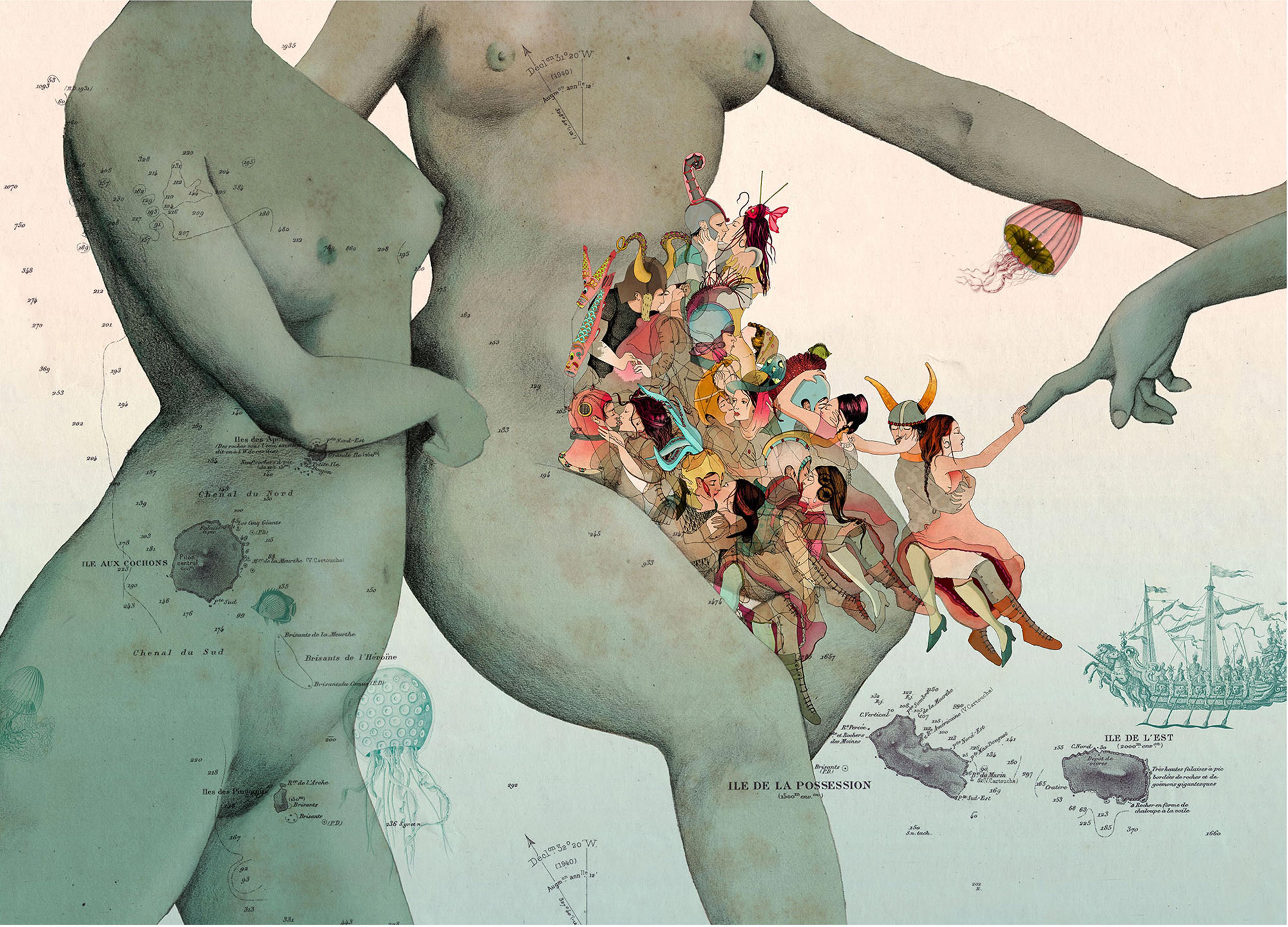We are shackled to the pangs and shocks of life, wrote Virginia Woolf in The Waves (1931), ‘as bodies to wild horses’. Or are we? Serge Faguet, a Russian-born tech entrepreneur and self-declared ‘extreme biohacker’, believes otherwise. He wants to tame the bucking steed of his own biochemistry via an elixir of drugs, implants, medical monitoring and behavioural ‘hacks’. In his personal quest to become one of the ‘immortal posthuman gods that cast off the limits of our biology and spread across the Universe’, Faguet claims to have spent upwards of $250,000 so far – including hiring ‘fashion models to have sex with in order to save time on dating and focus on other priorities’.
It’s easy to roll our eyes at such outré displays of entitlement in the Silicon Valley set. Other ‘transhumanist’ true believers awaiting their version of the rapture include the entrepreneur Elon Musk, the Googler Ray Kurzweil and the philosopher Nick Bostrom. Their end goal resembles a late-capitalist rendering of Leonardo da Vinci’s Vitruvian man: an individual super-human, armed with a wealth of cognitive and physical enhancements, elevated to a state of unassailable strength and power, and endowed with the ability to reproduce without the inconvenience of women. As transhumanists describe it, ‘immortality’ sounds like nothing so much as manspreading into the future.
What’s most instructive about transhumanism, though, isn’t really what it reveals about the hubris of rich white men. Rather, this movement is suggestive of what happens when a particular cast of mind, built on the sediment of centuries of philosophy, is taken to its logical extreme. Since Plato, generations of philosophers have been gripped by a fear of the body and the desire to transcend it – a wish that works hand-in-hand with a fear of women, and a desire to control them. In the dialogue Timaeus, Plato likens his theory of immaterial forms to a disciplinarian father; the force of these forms imposed order on all the unwieldy, material stuff in the world, which is nonetheless ‘the mother and receptacle of all created and visible and in any way sensible things’. Here Plato deploys a well-worn technique for suppressing corporeal angst: carving off the mind (rational, detached, inviolable, symbolically male) from the body (emotional, entangled, weak, symbolically female).
Plato’s legacy persisted into the Medieval world, as the split between form and matter assumed the moral complexion of Christianity. Humans were believed to be in possession of an immortal soul, which reason and restraint should shield from the corrupting influence of earthly pleasures. Women and the female body, the presumed targets of men’s sexual desire, therefore bore the semiotic burden of sin. The theologian St Augustine, for example, chastised himself for repeatedly succumbing to lustful urges in his youth, where women ‘found my soul beyond its portals, dwelling in the eye of my flesh’.
With the advent of modernity and the Enlightenment, this wish to detach from the material became a self-consciously scientific and rational enterprise. Spiritual transcendence wasn’t the point: the aim instead was to attain a vantage that offered an unimpeded vista on the natural world. Francis Bacon, a polymathic pioneer of the scientific method, was particularly fond of deploying sexual imagery to capture the relationship between reality and its observer. ‘Let us establish a chaste and lawful marriage between Mind and Nature,’ he wrote in The Refutation of Philosophies (1608) – with nature, of course, assuming the role of the docile wife. For Bacon, the ‘good scientist is a gallant suitor’, as the Australian philosopher Genevieve Lloyd notes in The Man of Reason (1984), while nature ‘is mysterious, aloof – but, for all that, eminently knowable and controllable’.
No wonder feminist thinkers have been so skeptical about attempts to raise ‘rationality’ above all else. The concept of reason itself is fashioned from a profoundly gendered blueprint. But a surprising rapprochement might be in sight: between feminists who criticise the mind/matter split, and certain philosophers and scientists who are now trying to put them back together. Fresh theories and findings about human cognition suggest that those feminised zones of physicality, emotion and desire not only affect the way we think, but are the very constituents of thought itself. So while some might yet hanker for an escape from our failing flesh, the best we can hope for is what the American biologist and feminist theorist Donna Haraway calls ‘staying with the trouble’: not flight and transcendence, but remaining with our messy bodies, and transgressing them.
The way we think about thought is political. This much was evident at the birth of the modern study of the mind, when Princess Elisabeth of Bohemia wrote to René Descartes in 1643 to question his account of cognition. Her self-deprecation will be familiar to any woman who’s dared to dispute with an eminence, and knows that the best way to begin is usually by mollifying his ego.
Unfortunately, Elisabeth writes, the rhythms of her domestic life simply don’t permit the sort of calm introspection that Descartes declares is the key to doing good philosophy:
The interests of my house (which I must not neglect) and conversations and social obligations (which I can’t avoid), inflict so much annoyance and boredom on this weak mind of mine that it is useless for anything else for a long time afterward. I hope that this will excuse my stupid inability to grasp what you want me to grasp.
The gauntlet she throws down to Descartes, however, is anything but feeble-minded. In his Meditations on First Philosophy (1641), he had claimed that the mind and body were made from two distinct substances, one immaterial and self-contained, the other material and extended out into the world. Elisabeth sees that this dualism poses a problem: how could such a floaty, incorporeal thing as the mind (cogito) cause a body to do anything, if each is made from quintessentially different stuff? Descartes is faced with a choice: either provide an account of some medium within which these substances interact, or admit that the mind is nothing special, emerging from matter just like everything else. The first option seems strange and unparsimonious, while the latter leaves no space for the mind to really do anything, since in principle it could be explained away by the underlying physical processes that bring it about.
A body enervated by the duties that attend on being a woman affects one’s capacity to think
This basic framing of the mind-body relationship remains dominant in both philosophical and scientific frameworks for the study of the mind. Today, the domain of ‘matter’ maps onto the brain, fed by signals and inputs from a body that perceives and reacts to the world; the ‘mind’, meanwhile, has become a collection of intangible phenomena such as psychology or consciousness. Since the mid-20th century, the most influential theorists and experimentalists have interpreted this Cartesian divide using the metaphor of computing. The brain is cast as a rule-based mechanism for manipulating abstract symbols and internal representations that somehow arrive at our awareness from the world outside via our perceptions. These perceptions are transformed into inner states such as beliefs, intentions or desires, and then translated algorithmically into actions. The brain needs a body, to be sure, but only the way a parasite needs a host, or software needs some kind of hardware on which to run. Our biohacking entrepreneur Faguet captures the essence of this view when he writes: ‘[Y]ou are a hackable, programmable biorobot constructed by evolution. You are just executing programs. Embrace the reality of what you are.’
But the mind-matter split, and its cognitive-computational descendants, are not logical necessities that follow from all attempts to understand the nature of thought. They’re really more like points of departure or grounding intuitions, and not everyone is going to share them. Elisabeth, for one, told Descartes that she leant towards physical reductionism over a dualist approach: ‘I would find it easier to concede matter and extension to the soul than to concede that an immaterial thing could move and be moved by a body.’ Her vignette about housework also serves as a sly criticism. She knows first-hand that a body enervated by the duties and niceties that attend on being a woman affects one’s capacity to think. Likewise, writing two years later from a Belgian hot-spring town, Elisabeth’s experience of illness makes her doubt Descartes’s assertion that virtue is largely about having the mental fortitude to follow the cool dictates of reason. ‘I still can’t rid myself of the doubt that one can arrive at the beatitude you speak of without help from things that don’t absolutely depend on the will,’ she says. Surely doing the right thing depends on many things beyond our control, Elisabeth argues – freedom from too many burdens, the correct upbringing, good health.
It’s not that Elisabeth simply rejected Descartes’s views without critical reflection, or fell back to simply asserting her subjective opinion. It’s that her particular life experience inclined her to develop different intuitions to him, and gave her good reasons to doubt the plausibility of dualism. As the philosopher Amia Srinivasan at the University of Oxford has argued, the contingencies of what happens to us in life – the people who have shaped us, the challenges we have overcome – invariably affect the sorts of claims that we’ll find persuasive or the arguments we’re inclined to doubt. Here, it seems to me that Elisabeth’s experience as a woman meant that she did not have the luxury of entertaining anxieties about the stark separation of mind and matter. One might think that her concerns – as for many women, in fact, and other oppressed peoples throughout history – were not really about how to bridge a gaping chasm between some enclosed inner world and a remote outer one. Rather, Elisabeth’s worry might well have been about how to preserve an inner sense of self against the relentless pressing-in of the world’s demands; about how to assert an entitlement to be a full person with distinct projects; and about how to carve out space to flourish in a society that relies on exploiting you.
While philosophers are inordinately fond of comparing humans to entities that are different to ‘us’ – zombies, bats, AIs, octopuses, aliens – they’ve been somewhat slower to show an interest in the complex lives of certain creatures who already live alongside ‘us’ day to day, who can walk and talk and describe their subjectivity, but who until recently have been shut out of the category of full and proper personhood. Feminist theory, concerned with the operation of patriarchy and the liberation of women, is a powerful tool for revealing the pernicious effects of setting women to the side – including how such exclusion might permit unexamined assumptions and questionable theories to persist.
In her classic text The Second Sex (1949), the French philosopher Simone de Beauvoir performed just such a move against the bedrock of Enlightenment philosophy, the knowing human subject. ‘Man is not a natural species: he is a historical idea,’ she said, paraphrasing her fellow philosopher Maurice Merleau-Ponty. The very idea of the Human is not some universal given, de Beauvoir claimed, but a byproduct of how societies have systematically degraded women:
The devaluation of woman represents a necessary stage in the history of humanity; for she derived her prestige not from her positive value but from man’s weakness; she incarnated disturbing natural mysteries: man escapes her grasp when he frees himself from nature.
Woman, in other words, is humanity’s foil. She is the ‘Other’, bearing the brand of the not-quite-Human, which lets man point at her and whisper: We know what we are, because, thank god, we are not that.
Thus when de Beauvoir makes the oft-quoted point that ‘one is not born, but rather becomes, woman’, she is not just saying that women’s minds and selves are socially constructed. More trenchantly, she is arguing that women become women precisely so that men can become Human. While the Human has access to Cartesian qualities of reason, truth and clarity, the Other is linked to irrationality, emotion and vagueness; where the Human has civilisation and culture, the Other is aligned with nature and matter; and where the Human has a honed and powerful mind, the Other is at the mercy of the body. De Beauvoir writes:
Man vainly forgets that his anatomy also includes hormones and testicles. He grasps his body as a direct and normal link with the world that he believes he apprehends in all objectivity, whereas he considers the woman’s body an obstacle, a prison, burdened by everything that particularises it.
The American philosopher Martha Nussbaum extends a version of de Beauvoir’s analysis in her book Political Emotions (2013). Drawing on child and developmental psychology, Nussbaum says that the human condition is framed by an awareness of vulnerability on the one hand, and the desire to change and control our reality on the other. This inescapable bind creates a universal impulse towards narcissism and disgust, she says. We feel disgust at our own mortal and fleshly nature, and at any reminders of our finitude and fragility as creatures. So we subordinate others in order to project onto them all the qualities that we wish to deny in ourselves – that they are base, animal, Other – while we imagine ourselves as transcending to the realm of the mighty, truly Human.
We transformed anxiety about determinism of nature into an equally untenable claim about determinism of culture
Armed with these arguments, feminists appear to face a stark choice. They can argue that women should be allowed to ascend from their denigrated state to the domain of the fully free and rational human, the move of a classic liberal feminist such as Mary Wollstonecraft. Just as men are not defined by their bodies, nor should we be. Alternatively, a feminist might reject this standard of humanity as hopelessly tainted and patriarchal, and suggest instead that we embrace the particularity of ‘female’ qualities. This latter strategy is evident, for example, in the American psychologist Carol Gilligan’s landmark study of women’s moral reasoning, In a Different Voice (1982), in which she argued that girls tend to think about ethical problems in terms of relations of care and emotion, while boys typically look at them through the lens of justice, reason and individualism. In a more overtly activist mode, traditions of ‘ecofeminism’ draw a connection between the generative features of ‘mother Earth’ and embodied, ‘maternal’ qualities such as fecundity and a capacity for nurture. (In the ecologically unstable era of the Anthropocene, however, we might be more inclined to view Gaia as ‘a tough bitch’, in the mordant phrase of the American evolutionary theorist Lynn Margulis.) Yet both camps fall into the trap of thinking that the body is somehow primeval and immutable – a substrate, a ‘given’ that can’t be changed or questioned.
In the 1980s, this presumption helped to push feminism’s focus towards gender, the set of social roles and practices that women are encouraged to perform, as distinct from their biological sex. The partition of women’s condition into sex and gender gave activists a way to demonstrate the effects of social norms and to wrest authority away from ‘the natural’. This strategy was undeniably transformative, but it also came at a cost. For one, the body began to occupy some sort of liminal state, at once profoundly important and oddly obscured. Feminists wrote about how it was policed, represented and symbolised, but it became difficult to talk about embodiment in overtly scientific or material terms, as if that would let some sort of malign, deterministic genie out of the bottle. Critics had rightly observed that biology and technoscience had been weaponised time and again to serve the needs and desires of men. These practices certainly deserved corrective doses of critique, but the decision to do so ended up trading away feminist influence on the scientific process from within. Moreover, it meant that if some area of the relations between men and women was to be transformed – childrearing, the workplace, sexuality – feminists had to frame gender, not sex, as the underlying cause of the problem. In this way, we transformed an anxiety about a determinism of nature into an equally untenable claim about a determinism of culture.
Meanwhile, as feminists turned their attention away from the life sciences, deeming them suspect beyond redemption, biologists and evolutionary psychologists continued to expand their influence and capture the attention of the public and policymakers. Sex became the ‘Achilles’ heel’ of feminism, as the American biologist and feminist theorist Anne Fausto-Sterling wrote in 2005:
We relegated it to the domain of biology and medicine, and biologists and medical scientists have spent the past 30 years expanding it into arenas we firmly believed to belong to our ally gender. Hormones, we learn (once more), cause naturally more assertive men to reach the top in the workplace. Rape is a behaviour that can be changed only with the greatest difficulty because it is wired somehow into men’s brains. The relative size of eggs and sperm dictate that men are naturally polygamous and women naturally monogamous. And more.
In other words, a feminist suspicion of instrumental scientific reasoning about the body – especially the sexed body – was totally understandable, but somewhat shortsighted.
In the face of this ‘oil spill of sex’, Fausto-Sterling thought that feminists face a different sort of choice. Either they can push back against each claim about the causal role of the biological body. Or they can grapple with the reality of a body made up of cells and nerves and tissues, but still look critically at how bodies absorb and are inscribed by culture – how physiology and society, nature and nurture, are constantly co-creating each other, to the point where it doesn’t make sense to look at either of them in isolation.
Imagine that someone presents you and a friend with a box, and asks you to take turns picking it up. According to the computational model of the mind, your brain takes in perceptual inputs from the body about the weight of the box, which then produces the feeling of how heavy it is when you lift it. Provided you and your friend are equally strong, then your sense of the weight of box should be similar. But that’s not what happens, according to a study in 2014 by the psychologists Eun Hee Lee and Simone Schnall at the University of Cambridge. These researchers found that people who felt themselves to be socially powerful experienced the physical burden as lighter than those with less social power. Similarly, participants in other studies who faced an uphill climb accompanied by a friend perceived the same slope to be less steep than those who had to go it alone; those who consumed glucose thought an incline looked shallower than those who’d had a calorie-neutral sweetener; and those in negative moods perceived the slant to be steeper than those with a more optimistic outlook.
Computational thinking remains dominant within cognitive science and philosophy of mind. But new frontiers are opening up that view the body as something more than just a brain-carrying robot. In doing so, they have created the potential for alliances with feminist thinkers influenced by the likes of Fausto-Sterling. Within a broad church that can be called – not uncontentiously – embodied cognition, a growing number of psychologists, scientists and theorists are approaching mental life as something that is not just contingent on, but constituted by, the state of our bodies. In the place of a Cartesian computer, the mind becomes more like a clay pot thrown on a wheel, to use the philosopher Michael Kirchhoff’s metaphor. The wet clay spins on a rotating disk, shaping and reshaping itself under the potter’s hands, arms and muscles, which in turn respond to how the material is moving. The mind is moulded by forces operating both within it and upon it, but also linked up to the world and the body as a single, dynamic yet mostly stable system.
It takes only a small leap to see the political potential of embodied cognition for feminists seeking a path out of the quagmire of sex and gender – or indeed any other critical social theorists keen to overthrow falsely naturalised and unjust hierarchies. Embodied cognition allows us to recognise the agency of biology without ceding the significance of power or politics. In her essay ‘Throwing Like a Girl’ (1980), the American philosopher Iris Marion Young cites empirical research suggesting that women playing sport are more likely than men to perceive a ball to be coming at them, aggressively, rather than towards them; they also tend not to trust their bodies, and to experience their limbs as awkward encumbrances rather than tools to help them realise their aims. Drawing on the work of de Beauvoir, Young suggests that female bodily experience is often rooted ‘in the fact that feminine existence experiences the body as a mere thing – a fragile thing, which must be picked up and coaxed into movement, a thing that exists as looked at and acted upon.’ But Young denies that this state of affairs is in any way natural, or that it flows from something intrinsic to female biology; instead, she says, such feelings are byproducts of how women learn to live in their bodies. One therefore doesn’t need some essential definition of ‘female’ to accept that embodiment matters, and to see how it shapes and can be shaped by culture.
While embodied cognition has grown in popularity in recent years, it flows from a long history of counter-Cartesian philosophical psychology that predates the mainstream model of the computational mind. De Beauvoir is often read as a deeply anti-biological feminist who inaugurated the sex/gender divide avant la lettre, but this overlooks her explicit acknowledgement of debt to the embodied phenomenology of Martin Heidegger and Merleau-Ponty. These thinkers were committed to the importance of the body, not as a mere thing in the world, but the ground and origin of each organism’s own reality, the very means of thought. ‘Because the body is the instrument of our hold on the world, the world appears different to us depending on how it is grasped,’ de Beauvoir writes. ‘[T]he body is not a thing, it is a situation: it is our grasp on the world and the outline for our projects.’ In phenomenology, the body becomes the reference-point for an individual’s experience. It is something that doesn’t simply record or register abstract representations, as if they are shapes being pressed into inert plaster; rather, it draws forth aspects of the environment that a particular creature deems meaningful at that moment in time. Heidegger’s favourite example was a hammer. Recognising that hammer, in terms of understanding what it is and what it can do, will depend on your prior bodily experience with a hammer. Only if you’ve hefted something like it in your hand before will you be able to guess whether it’s too heavy or too light for a task. To recognise a hammer is to appreciate its significance to you, in that moment, which inturn requires you to have some prior feeling for the action of hammering.
Against Descartes, the body indeed thinks; it’s the very tool by which meanings are offered up to consciousness
The case of Mike May, an American professional skier, shows what this might mean in practice. At the age of three, May lost his sight when a chemical explosion from a lantern destroyed his left eye and scarred his right cornea. Remarkably, in 1999, at the age of 46, his sight was restored by a corneal transplant. But that did not mean he could see, in any standard sense of the word. Instead of cars, cats, people and trees, May saw only moving lines and blotches of colour. It’s unclear what accounts for May’s struggle to see after a 40-year hiatus; after all, he would seem to have access to all the same visual data as any other sighted person. According to the psychologist Louise Barrett and the neuroscientist Moshe Bar: ‘These ideas also suggest the intriguing possibility that exposure to visual sensations alone is not sufficient for visual experience.’ They thought that the reason for May’s continuing problems was because he had been denied the chance to connect the sight of objects to other bodily sensations at a crucial stage of childhood development. In their view, humans do not use our senses to develop an abstract representation of objects in the world, and only then graft on our feelings about such things. Instead, we see ‘with feeling’: we learn to see a cat or a tree by linking it to our history of bodily engagements, such as their smell, touch or the emotions it evokes when we see one. We do not reason from a position of detachment, but rather with a history of embodied encounters under our belts that allows us to make sense out of the world, quite literally.
Like Heidegger, the American philosopher and psychologist William James also believed that our core cognitive processes were afterimages of the ebb and flow of our various bodily states as we navigated the world. Take fear: without the feelings of ‘quickened heart-beats nor of shallow breathing, neither of trembling lips nor of weakened limbs, neither of goose-flesh nor of visceral stirrings,’ James argued in 1884, we’d be incapable of grasping the concept. Likewise for grief, for ‘what would it be without its tears, its sobs, its suffocation of the heart, its pang in the breast-bone?’ Against Descartes, the body indeed thinks; it’s the very tool by which meanings are offered up to consciousness.
While computationalism has dominated mainstream psychology for decades, this countercurrent of emotional and embodied approaches to the mind has continued to pulse beneath the surface. In the 1970s, the American psychologist James J Gibson developed the influential notion of affordances, and inaugurated what came to be known as ‘ecological psychology’. Gibson argued that the computational mind, manipulating content-bearing representations, was not the correct way to understand perception. The only reason we’ve evolved and learned to experience particular aspects in our environment such as red and green, hardness and softness, heaviness or lightness, or even if things are alive or dead, he claimed, is that such qualities must have ‘afforded’ us opportunities to act in certain ways that could enhance our chances of survival. Seeing whether a berry was red or green might have allowed us to figure out whether it was ripe (or poisonous). Lifting a stone in one’s hand might help one tell the difference between a piece of charcoal (for lighting a fire) and a piece of granite (for fashioning a tool). Such features of the world, to paraphrase the English anthropologist Gregory Bateson, are ‘differences that make a difference’. They are differences that have come to matter, to have significance for that creature in the context of its life and objectives. They are not mediated by any abstract symbols within a removed cogito, but exist only in the sense that they arise from the way that we couple or grip onto what’s around us. Affordances, in other words, are inextricable from the meaning and purpose of our actions.
What the world affords you depends on your history: on what the world has already afforded you
Clearly, affordances must develop in a way that’s relevant to an organism’s particular goals and abilities, including bodily goals and abilities, from moment to moment. Water affords breathing to a fish but not to a flamingo; stairs afford walking to someone with functioning legs, but not to someone in a wheelchair. Similarly, to return to some of those earlier experiments, a hill might afford walking more readily – and so be perceived as gentler and more manageable – when you already feel yourself to be powerful, when you have the support of a companion, or you’ve just loaded up on calories. Moreover, what the world affords you depends on your history: on what the world has already afforded you, or on what affordances you have acquired from your experience. That is, perceptions and actions exist in a feedback loop. A notepad affords note-taking to a writer, but sketching to an artist, and possibly very little to someone who has been denied an education and is illiterate. From Young’s earlier example, perhaps balls often do not afford catching to a girl in the way that they might to a boy, because of the different opportunities that boys and girls have been given to pick up and reinforce certain strategies for how to engage with the world in a bodily way. ‘The young girl acquires many subtle habits of feminine bodily comportment – walking like a girl, tilting her head like a girl, standing and sitting like a girl, gesturing like a girl,’ Young notes. ‘The girl learns actively to hamper her movements.’
One of the most recent, and increasingly influential, strands of the embodied picture concerns the role of expectations in shaping our experience. Rather than building up a picture of the world from the ‘bottom up’ using sensory data, a growing body of work in cognitive science indicates that we often construct the world by creating models that allow us to predict it from the ‘top down’. (For some, such as the philosopher Jakob Hohwy at Monash University in Australia, talk of prediction heralds a return to a Cartesian picture of a detached, hypothesising cogito; but for many others, such as Andy Clark at the University of Edinburgh, these predictions are necessarily built from experience, and have a richer relationship to action and embodiment.) What registers in our awareness is the gap between our anticipated and actual sensory states, and our goal as organisms is to keep that gap or ‘surprise’ as small as possible. In broad terms, to see a cat means having a pre-existing model of a cat that predicts its existence, and then to fit the data to that model. If one accepts the Gibsonian picture of cognition, what we are expecting is in fact a changing landscape of affordances, those felt, meaningful aspects of the world that we perceive – and predict – in order to facilitate our actions.
These models are born of feedback loops as well as sifting out information that does not conform to our predictions. For that reason, we also tend to act in a way that ensures our sense-data matches what we expect. There are echoes here of what the author Henry David Thoreau in 1862 called the ‘thrilled and expectant mood’ in his studies of nature at Walden:
Objects are concealed from our view not so much because they are out of the course of our visual ray as because we do not bring our minds and eyes to bear on them … We cannot see anything until we are possessed with the idea of it, and then we can hardly see anything else.
All this talk of expectations and affordances leads to a potentially troublesome consequence: cognition can no longer be cleaved apart neatly from politics. If I am black, my prediction of what a police officer might afford me is likely to be very different to that of my white friend, as well as eliciting very different felt responses and perceptions. Undoing such expectations (which it might well be reasonable for me to hold) is not just a matter of changing my beliefs, but of modifying longstanding physiological reactions. Similarly, as a woman, I might not expect a dark and deserted street to afford me walking down it at night, while my male partner might be entirely at ease in that space. The fact that I feel myself to be vulnerable, in a very visceral way, means that I will avoid putting myself in that position, and so my predictions will be tacitly reinforced. The embodied world, as each of us encounters it, is a product of such self-reinforcing causal loops.
Does embodied cognition get us feminists any closer to a recipe for women’s emancipation – one that avoids an unappetising choice between the unmoored human universal on the one hand, and an essentialist concept of ‘the female’ on the other? There are certainly hints of what a more malleable and creative feminist biopolitics might look like. In Testo Junkie (2008), the Spanish activist and writer Paul Preciado, previously Beatriz Preciado, gives a vertiginous account of his illicit application of topical testosterone. Preciado is clear that he’s not after any kind of ‘standard’ transition from one sex or gender to another; he does not take himself to be peeling away the female to reveal some concealed, genuine, male essence:
The truth about sex is not a disclosure; it is sexdesign … I don’t want to change my sex, and I don’t want to declare myself dysphoric about whatever it may be; I don’t want a doctor to decide how much testosterone a month is suitable for changing my voice and making me grow a beard; I don’t want to have my ovaries and breasts removed.
The body becomes a malleable substance – something that Preciado can toy and tinker with, rather than control and engineer.
Preciado displays neither a nostalgia for biological fixity, nor some techno-fantasy of embodiment as something that can be simply cast aside. His image of himself is closer to the transgressive feminist being that Haraway calls a ‘cyborg’: a co-evolving hybrid that emerges from a mosaic of technology and biology, thought and feeling, the material and the mental. These entities are a far cry from the demigods that Silicon Valley has in its sights. Instead, Haraway’s cyborgs revel in their own ragged borders, the cross-pollination and pollution of their biological and technological components, their entanglement and reliance on other creatures, their leakiness and unpredictability. ‘It’s not just that “god” is dead; so is the “goddess”,’ Haraway exults: there are ‘great riches for feminists in explicitly embracing the possibilities inherent in the breakdown of clean distinctions between organism and machine’.
Embodied cognition offers a way out of a false choice for a future feminist agenda: between a politics grounded in an essentialised notion of the female body, and one that risks quashing the particularity of women’s experience by forcing it to measure up to some falsely universal norm. Instead it leaves us with a view of women’s condition as being a biocultural artifact, enmeshed in tangled relationships with nature and matter that can be moulded and rewired, if not upturned overnight. In the place of Faguet’s invincible and omnipotent transhuman, embodied feminism might yield a figure more like Moon Ribas, a Catalan artist with a sensor permanently implanted in her arm that allows her to feel earthquakes anywhere on the planet.
To recognise that our bodies are steeped in and fashioned by culture also means facing up to the unpleasant fact that we are vulnerable to manipulation and control. The infiltration of digital devices into the most intimate crannies of our lives makes it harder and harder to cling to the belief that humans possess truly autonomous, bounded, sovereign minds. Maybe we don’t need to look on this development with alarm, but see it as history granting us a form of permission – a licence to experiment with new kinds of empathy, fresh identities, and a range of more interesting, hybrid selves.






